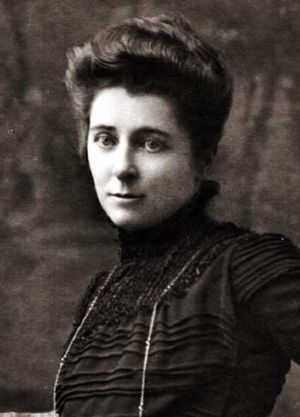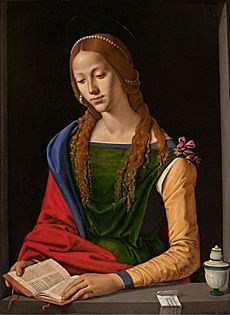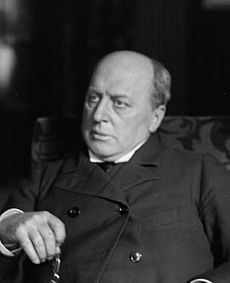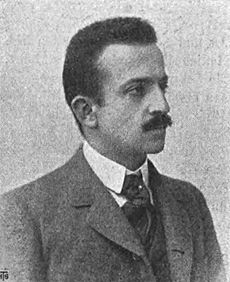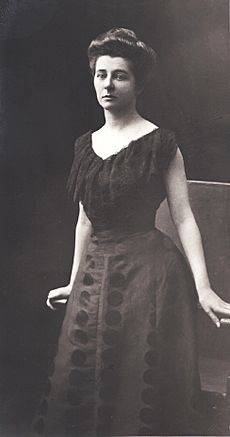Caroline Fitzgerald facts for kids
Caroline Fitzgerald (September 22, 1865 – December 25, 1911) was an American poet and writer. She spent most of her adult life in Europe, especially in Italy. Caroline was quite wealthy, which allowed her to travel often between America during the Gilded Age and Europe during the Belle Époque.
She was inspired by the famous poet Robert Browning. Caroline published a book of her own poems that was popular at the time. Later, her work became almost forgotten. She married an English nobleman, Lord Edmond Fitzmaurice. After a few years, she was able to get their marriage officially cancelled.
After her marriage ended, she traveled widely in Europe as a single woman. She became friends with important writers like Henry James and Sir Frederic Kenyon. She also formed special connections with two men who were just starting their careers. In 1901, she married Filippo De Filippi, an Italian doctor, professor, explorer, and mountaineer. They traveled together through Central Asia and India. Their happy marriage ended when she passed away in 1911 at age forty-six.
A book about her life, published in 2018, shows how her story was similar to characters in novels by Henry James. She knew James well, and her life was like that of characters such as Isabel Archer in The Portrait of a Lady.
Contents
Caroline's Early Life
Caroline Fitzgerald was born on September 22, 1865, in Litchfield, Connecticut. Her parents were William John Fitzgerald and Mary Ann White. Her father was born in 1819 in Litchfield. He came from a well-known family with Irish roots. He studied law and became a lawyer in Toronto. Caroline's mother's father, Eli White, was a rich merchant from New York.
Caroline had two brothers. Her older brother, Augustine (called Austin), was born in New York in 1862. He went to Yale and became a landscape painter. Her younger brother, Edward, was born in Litchfield in 1871. He went to Trinity College, Cambridge, became a mountaineer, and joined the army.
As a young woman, Caroline was well-known in New York's literary circles. She was very smart and studied old languages like Sanskrit, which was unusual for women at that time.
In 1876, she went to Europe with her family for about eighteen months. Then they returned to America and lived on Mount Desert Island in Maine. Caroline wrote in her diary that she wrote her first poem in 1881. Between 1881 and 1882, her family moved between America and Europe, spending time in Switzerland. In 1883, they lived in London, and in 1884, they lived in Geneva.

In 1884, the artist Edward Burne-Jones painted her portrait. It was shown in the New Gallery in London. Her biographer, Gottardo Pallastrelli, said she looked thoughtful and a bit sad in the painting. He compared it to Piero di Cosimo's painting of Maria Maddalena. In London, Caroline wore long oriental dresses, which was very unusual for American women looking for husbands back then.
Also in 1884, she met the 72-year-old poet Robert Browning. He became a huge inspiration for her poetry. Caroline often had poor health with lung issues. Because of this, she moved to the spa town of Cauterets in France. The next year, she returned to Litchfield. In 1888, she met Browning again in London and Venice, where he lived. She wrote in her diary that these meetings were very important to her. In 1889, she wrote to Browning, saying that writing to him was almost as good as talking to him. Sadly, Browning died soon after, on December 12, 1889.
In 1888, Bertrand Russell, who was sixteen, went to school with her younger brother Edward. Russell became a friend of the Fitzgerald family. He admired Caroline greatly. Russell thought she was "the ideal of young womanhood." He said she had "liberal ideas in politics and religion, was free from common prejudices, and was very cultured and well-read."
Caroline's Poetry
Fitzgerald first published her poems in 1889. The collection was called Venetia Victrix and Other Poems. She dedicated it "To my friend Robert Browning." A handwritten copy of the first poem, "Vates Ignotus", is from 1887. It is known that Browning read some of her poems. Her second book of poetry, published in 1904, was also dedicated to him. The first part of "Vates Ignotus" is:
Ye gods that, from Olympus' height,
Lean to the music of his lyre,
Who binds the world in links of light,
Consenting to the high desire
That turns pure hearts to meet his fire,
What time long shadows leave the grass,
And heaven's clear echoes cloudward pass
To swell his earth's responsive choir;
Oscar Wilde wrote a review of Venetia Victrix in an article called "Three New Poets" for the Pall Mall Gazette. He liked that Browning's influence was clear in her work. Wilde said that "Venetia Victrix" showed "strength, intelligence, and courage." Wilde also wrote a longer review in The Woman's World magazine, where he was the editor. One of her poems, "Hymn to Persephone," was included in a 1996 collection called British Women Poets of the Nineteenth Century.
First Marriage and Its End
On November 23, 1889, Caroline married Edmond George Fitzmaurice. He was 43, and she was 24. Edmond had studied at Eton and Cambridge. He had been a Liberal MP and a government minister. In 1889, he was not in office. They likely met in Toronto, where Edmond's older brother, Henry, Marquis of Landsdowne, was the Governor General of Canada. From the very beginning, their marriage was not successful and quickly failed.
Caroline loved cultural activities, but her husband preferred a quiet country life with little intellectual discussion. Over time, they began to live separately, with Caroline staying in their London home. She often wrote (sometimes in Italian) to an old family friend, James Lacaita, who lived in Florence. She explained how unhappy she was. Even though she was distant from her husband, she remained very close with her mother-in-law.
Many marriages between American socialites and English noblemen faced similar problems. However, few ended in divorce because it was considered a scandal. But Caroline was determined to be free again. She especially loved Italy and wanted to live there. She decided to get her marriage officially cancelled, claiming it had never been fully completed.
Under English law, a marriage could not be cancelled for this reason until it had lasted three years. So, in August 1894, Caroline went to court. Her husband did not object. A decree of nullity was made in October 1894 and became final in May 1895. After the marriage was cancelled, she tried to return some of her husband's family jewelry. But his mother and aunt told her to keep them. They said nothing had happened that should make her want to give them back, and they wanted to avoid causing her more pain.
In 1894, Bertrand Russell wrote to his fiancée, Alys Pearsall Smith. He said that when he heard about Caroline's upcoming divorce, he had always regretted her marriage. He felt "a sort of joy to think she should get rid of him and start afresh." He thought she married for ambition, not love. In Russell's 1967 autobiography, he also said that "later she seemed an unmitigated bore." Perhaps his sadness about her first marriage still affected him.
Friendship with Henry James
Before her marriage ended, Caroline Fitzgerald spent her time reading books and keeping up with current events. She also wrote many letters to Fanny Reay, the wife of Donald Mackay, 11th Lord Reay. Even though they had an age difference, the two women got along very well. They shared many interests and became close friends.
From these letters, it is clear that Caroline spent time with both noble families and intellectuals. In 1895, at a party held by her publishers, she met the famous author Henry James. The next year, they started writing to each other regularly. James had already published his most famous novels. At this time, he was writing more experimental novels and plays, which were not as successful. He sometimes felt very sad and no longer felt comfortable in London society. He thought about leaving the city, finding more peace in the countryside at Rye. Caroline, however, enjoyed London's social life.
Life in Europe
Caroline traveled around Europe for long periods, visiting major cultural cities. She especially loved the buildings in Florence. During her travels, she met up with friends, especially American people living abroad, who welcomed her. In 1897, the cultural and intellectual atmosphere of Rome felt a bit overwhelming to her. When she met Max Müller, a German philosopher, he told her he had felt the same way at first.
As time went on, she became more confident. She began to appreciate the joy of seeing new places and meeting different people. She met writers, painters, poets, and thinkers. Rome eventually became her favorite city to live in.
In Florence, she met a young German archeologist named Georg Karo. He fell in love with her. She was happy for him to join her on her trips, feeling safer with him than alone. She was also happy to meet his mother and sister. He introduced her to cycling, which was a new hobby. She grew very fond of living in Rome, enjoying its cultural life, going to the opera, and meeting many people who shared her interests.
Elizabeth Barrett Browning's Letters
Sir Frederic Kenyon was preparing a book of letters by Elizabeth Barrett Browning for publication. He asked Caroline for her thoughts on Robert Browning as a person. She eagerly joined the project. She did some research, helped choose the letters, and visited the old places where Robert and Elizabeth had lived. Kenyon thanked her (as Lady Edmond Fitzmaurice) when the book was published in 1897. She continued to write to Kenyon for the rest of her life.
Caroline was very good at literary criticism. When Kenyon and Fitzgerald thought about writing a biography of Robert Browning together, she wrote:
I agree with you in thinking that this begins at a later period than these proofs have reached, only confirms my view that Elizabeth Barrett Browning began to exist when she knew the greater poet – and I am glad you have kept so many of the really rather dull early letters, for they prove that and form a document beyond the scope of anecdotal memoire.
After being back in England for a while, she went to Florence. There, she visited the Brownings' old house, Casa Guidi. With Karo's help, she was able to meet their only son, Robert Barrett Browning.
Filippo De Filippi and Second Marriage
In early 1898, Caroline Fitzgerald met Filippo De Filippi. He was a mountaineer, explorer, and a professor of surgery at the University of Bologna. De Filippi was 28 years old. The year before, he had climbed Mount Saint Elias in Alaska with the Duke of the Abruzzi. Caroline met him when she went to a mountaineering lecture he gave in Rome.
Soon after, he went with Caroline's mother to a similar lecture in London. This lecture was given by Caroline's brother, Edward, who was also a famous mountaineer. Caroline had invited Henry James to this lecture too, but he couldn't come. From a letter James wrote to her a few days later, it's clear she had told him about her new friendship with "De Filippi," someone "extremely interesting." James and Caroline wrote to each other more and more often. James encouraged her to continue her friendship with De Filippi, even though she still had a kind relationship with Karo.
De Filippi felt a bit overwhelmed by Caroline's intelligence and the high society she was part of. In May 1898, he wrote to his mother, doubting he had any hope of marrying Caroline. But over the next couple of years, they kept meeting. He told her he was in love with her, but she was unsure. By 1901, he was writing very emotional love letters. He was very sad when Caroline returned to England. Then, in May, she arranged a meeting with her mother and De Filippi. Her mother approved of their marriage.
De Filippi then had to explain to his parents why Caroline had been divorced. He used the example of the Ruskins to help them understand. Other problems also had to be solved. The United States considered Caroline a British citizen, and Britain considered her an American citizen. Also, by British custom, she was still called "Lady Edmond," which in Italy made people think she was still married. In August, they visited Scotland together. On September 3, 1901, they got married and toured the Swiss Alps for their honeymoon.
The couple bought a house in Rome. By 1902, they had bought a car for touring. They invited Henry James on trips with them. James then encouraged Edith Wharton to get a car too, which she did in 1904.
Since her childhood in America, Caroline had remained close to the Peskovs. They were a Russian family who owned a castle in Salzburg. In 1903, Caroline and Filippo traveled with the Peskovs through Russia and the Caucasus to Turkestan. They visited places like Astrakhan, Bokhara, Samarkand, and Tashkent. They returned past the Black Sea and Crimea.
De Filippi was supposed to go on an expedition in 1906 to the Rwenzori Mountains in Africa. This trip was also led by Abruzzi. But Caroline was ill after the Turkestan tour, so Filippo stayed home with her. Even with her poor health, they still traveled a lot in Europe. In 1907, they met Edith Wharton in Paris.
In 1909, Abruzzi invited De Filippi on another expedition. This time it was to the Baltoro Glacier, near K2 in the Karakoram mountains. Caroline traveled with him as far as Kashmir, sailing on the SS Oceana. She stayed in Srinigar and later Gulmarg while she waited for the expedition to return. Then they traveled together through Ladakh. Caroline was one of the translators for the English version of the large two-volume report about this trip.
Death and Legacy
Caroline Fitzgerald became weaker from her travels and suffered from pneumonia. She passed away on December 25, 1911, at her home in Rome, after a long illness. She is remembered on a plaque with De Filippi at the Protestant Cemetery in Rome, near Shelley's grave. However, she is buried in her hometown of Litchfield, Connecticut, in the East Cemetery.
De Filippi wrote to his friend, the explorer Aurel Stein, that his life no longer made sense and that he was heartbroken. According to Tom Longstaff, who wrote De Filippi's obituary in 1938, he never fully recovered from his wife's death. Still, he worked tirelessly. He planned a large and very successful expedition to Kashmir, Baltistan, and Ladakh, which he led in 1913 and 1914.
Caroline Fitzgerald lived during both the Gilded Age in America and the Belle Époque in Europe. Her biographer says that her life was very similar to some of the American female characters in Henry James's novels. These characters include Christina Light in Roderick Hudson (1875) and The Princess Casamassima (1886); the main character in Daisy Miller (1878); Isabel Archer in The Portrait of a Lady (1880); and Milly Theale in The Wings of the Dove (1902). These women took responsibility for their own choices and lived their lives without giving up on what they believed in.
| 1860s births: | 1860-1861-1862-1863-1864-1865-1866-1867-1868-1869 |
This category has articles on people who were born in the year 1865.
See also: 1865 deaths.
| 1910s deaths: | 1910-1911-1912-1913-1914-1915-1916-1917-1918-1919 |
This category has articles on people who died in the year 1911.
See also: 1911 births.
Category:American women poetsCategory:19th-century American women writersCategory:Poets from ConnecticutCategory:Victorian poetsCategory:American expatriates in ItalyCategory:American expatriates in EnglandCategory:Gilded AgeCategory:American translatorsCategory:20th-century translatorsCategory:Italian–English translatorsCategory:Belle Époque


